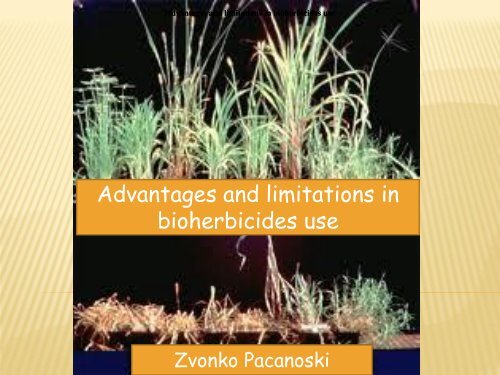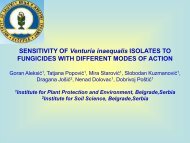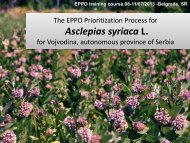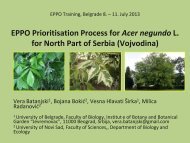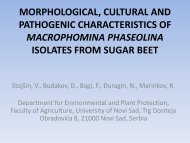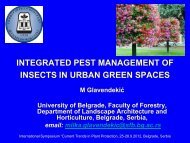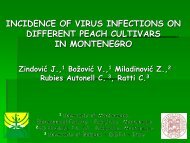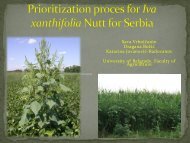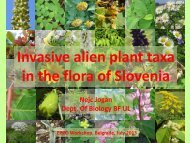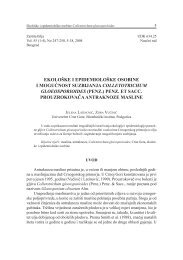Advantages and limitations in bioherbicides use
Advantages and limitations in bioherbicides use - Zvonko ... - Izbis
Advantages and limitations in bioherbicides use - Zvonko ... - Izbis
- No tags were found...
Create successful ePaper yourself
Turn your PDF publications into a flip-book with our unique Google optimized e-Paper software.
<strong>Advantages</strong> <strong>and</strong> <strong>limitations</strong> <strong>in</strong> <strong>bioherbicides</strong> <strong>use</strong><br />
<strong>Advantages</strong> <strong>and</strong> <strong>limitations</strong> <strong>in</strong><br />
<strong>bioherbicides</strong> <strong>use</strong><br />
Zvonko Pacanoski
Limitations of <strong>bioherbicides</strong>:<br />
- biological constra<strong>in</strong>ts<br />
- environment constra<strong>in</strong>ts<br />
- technical constra<strong>in</strong>ts <strong>and</strong><br />
- commercial <strong>limitations</strong><br />
Bioherbicides<br />
phytopathogenic microorganisms or<br />
microbial phytotox<strong>in</strong>s <strong>use</strong>ful for biological<br />
weed control applied <strong>in</strong> similar ways to<br />
conventional herbicides (Goeden, 1999;<br />
Boyetchko et al., 2002; Boyetchko <strong>and</strong><br />
Peng, 2004)<br />
Bioherbicides serves a more important role as a complimentary<br />
component <strong>in</strong> successful <strong>in</strong>tegrated management strategies<br />
(Hoagl<strong>and</strong> et al., 2007), <strong>and</strong> not as a replacement for chemical<br />
herbicides <strong>and</strong> other weed management tactics (S<strong>in</strong>gh et al., 2006)<br />
<strong>Advantages</strong> of <strong>bioherbicides</strong>:<br />
high degree of specificity of target weed;<br />
no effect on non-target <strong>and</strong> beneficial plants or man;<br />
absence of residue build-up <strong>in</strong> the environment;<br />
effectiveness for manag<strong>in</strong>g herbicide-resistant (HR) weed populations
Successful stories about <strong>bioherbicides</strong><br />
commercialized<br />
<strong>bioherbicides</strong><br />
200 plant pathogens<br />
c<strong>and</strong>idates for development as<br />
commercial <strong>bioherbicides</strong><br />
Plectosporium tabac<strong>in</strong>um<br />
Galium spp.
Colletotrichum truncatum<br />
Sesbania exaltata<br />
Fusarium oxysporum (PSM 197)<br />
S. asiatica (91.3%) S. hermonthica (94.3%) S. gesneroides (81.8%)
Myrothecium verrucaria (IMI 361690)<br />
Chenopodium<br />
amaranticolor<br />
Sesbania exaltata Senna obtusifolia Datura stramonium<br />
Trichothecene<br />
Orobanche ramosa seeds
Myrothecium verrucaria<br />
Portulaca oleracea<br />
Portulaca<br />
portulacastrum<br />
Euphorbia maculata Euphorbia prostrata<br />
Phomopsis amaranthicola<br />
Amaranthus spp.
Microsphaeropsis amaranthi Phomopsis amaranthicola Amaranthus spp.<br />
Pyricularia setariae Setaria viridis sethoxydim<br />
Colletotrichum truncatum<br />
Sesbania exaltata
Dactylaria higg<strong>in</strong>sii<br />
Cyperus routndus<br />
Drechslera avenacea<br />
Avena fatua
Synergism between <strong>bioherbicides</strong><br />
<strong>and</strong> chemical herbicides<br />
Comb<strong>in</strong>ations of some <strong>bioherbicides</strong> <strong>and</strong> synthetic herbicides can be<br />
synergistic (Caulder <strong>and</strong> Stowell, 1988; Christy et al. 1993), result<strong>in</strong>g<br />
from lowered weed defense responses ca<strong>use</strong>d by the herbicides, thus<br />
mak<strong>in</strong>g the weeds more susceptible to pathogen attack (Hoagl<strong>and</strong>, 1996;<br />
2000).<br />
Synergism<br />
trimethylsulfonium salt of glyphosate<br />
Xanthomonas campestris
Fusarium lateritium<br />
Desmodium tortuosum<br />
Alternaria cassiae<br />
Senna obtusifolia<br />
acifluorfen<br />
Colletotrichum gloesporioides Aeschynomene virg<strong>in</strong>ica<br />
Synergism<br />
Colletotrichum truncatum<br />
Sesbania exaltata<br />
bentazon
Glyphosate<br />
Synergism<br />
Myrothecium verrucaria<br />
Brunnichia ovata (88%) Campsis radicans (90%)
Phoma proboscis<br />
Synergism<br />
2,4-D<br />
MCPP<br />
MCPP<br />
Convolvulus arvensis<br />
yrothecium verrucaria Silwet L-77 Pueraria lobata<br />
(100 <strong>and</strong> 90-100%)
Different <strong>limitations</strong> about <strong>bioherbicides</strong> <strong>use</strong><br />
1. Environmental <strong>limitations</strong><br />
Environmental factors <strong>in</strong>fluence formulation performance of <strong>bioherbicides</strong> as<br />
<strong>in</strong>oculum production is dependent on sporelation of the formulation.<br />
In the application of <strong>bioherbicides</strong>, environmental conditions prevail<strong>in</strong>g <strong>in</strong><br />
the phyllosphere of plants are frequently hostile for biological control<br />
agents (KENERLEY & ANDREWS, 1990; ANDREWS, 1992).<br />
phyllosphere of plants<br />
A requirement for more than 12 h of dew period for severe <strong>in</strong>fection by a<br />
pathogen, has been reported for several potential <strong>bioherbicides</strong> (BOYETTE<br />
& WALKER, 1985; WYMORE et al., 1988; MORIN et al., 1990; MAKOWSKI,<br />
1993) <strong>and</strong> this may limit the efficacy of the bioherbicide <strong>in</strong> the field.<br />
dew period
Soil<br />
environment<br />
Soil moisture<br />
Nutrient status of the<br />
soil<br />
physiology of target plants<br />
Colletotrichum truncatum Sesbania exaltata (95%)
Biological <strong>limitations</strong><br />
It is desirable for a bioherbicide to act relatively quickly <strong>and</strong> have sufficient<br />
efficacy to control weeds. Unfortunately, many of the weed pathogens<br />
discovered may provide only partial control of only one weed species, even under<br />
ideal conditions (CHARUDATTAN, 2005).<br />
Host specificity is related to the basic biology of the pathogen <strong>and</strong> to host<br />
variability (GABRIEL, 1991; LEONARD, 1982). Biological constra<strong>in</strong>ts <strong>in</strong>clud<strong>in</strong>g<br />
host variability <strong>and</strong> resistance, as well (AULD, 2003).<br />
?<br />
Chondrostereum purpureum<br />
Prunus serot<strong>in</strong>a
Colletotrichum orbiculare<br />
Xanthium sp<strong>in</strong>osum<br />
Technological-commercial <strong>limitations</strong><br />
Several technological <strong>limitations</strong> have been identified that could prevent the<br />
widespread <strong>use</strong> of <strong>bioherbicides</strong><br />
Pathogenical stra<strong>in</strong>s, formulation method <strong>and</strong> the <strong>in</strong>teraction of these two<br />
parameters significantly affect the shelf life of the formulations at room<br />
temperature (ALTMAN et al., 1990; HEBBAR et al., 1998).<br />
The most challeng<strong>in</strong>g aspect of formulat<strong>in</strong>g <strong>bioherbicides</strong> is to overcome the dew<br />
requirement that exists for several of them.<br />
water-reta<strong>in</strong><strong>in</strong>g materials<br />
<strong>in</strong>vert emulsion<br />
vegetable oil emulsion
spray dry<strong>in</strong>g process Phomopsis sp. Carthamus lanatus<br />
Alternaria eichhorneae<br />
alg<strong>in</strong>ates<br />
liquid formulations<br />
of <strong>bioherbicides</strong><br />
gellan gum<br />
polyacrylamide
Conclusion<br />
The <strong>bioherbicides</strong> approach is ga<strong>in</strong><strong>in</strong>g momentum<br />
New <strong>bioherbicides</strong> will f<strong>in</strong>d place <strong>in</strong> irrigated l<strong>and</strong>s, wastel<strong>and</strong>s as well<br />
as <strong>in</strong> parasite weeds or resistant weed control<br />
Research on synergy test of pathogens <strong>and</strong> herbicides for <strong>in</strong>clusion <strong>in</strong><br />
IWM, developmental technology, fungal tox<strong>in</strong>s, <strong>and</strong> application of<br />
biotechnology, especially genetic eng<strong>in</strong>eer<strong>in</strong>g is required<br />
Bioherbicides will not solve all of the environmental <strong>and</strong> weed<br />
management problems associated with synthetic herbicides, nor will<br />
replace the current or future arsenal of synthetic herbicides<br />
Their role will probably be complimentary components <strong>in</strong> successful IWM<br />
systems, <strong>and</strong> <strong>in</strong> the discovery of novel phytotox<strong>in</strong>s with new chemistries<br />
<strong>and</strong> new molecular sites of action<br />
Cont<strong>in</strong>ued research on these areas is important <strong>in</strong> order to fully<br />
underst<strong>and</strong> <strong>in</strong>teractions of microorganisms <strong>and</strong> plants (crops <strong>and</strong><br />
weeds), <strong>and</strong> to discover new phytopathogenic microorganisms or<br />
microbial phytotox<strong>in</strong>s <strong>use</strong>ful as <strong>bioherbicides</strong>
References<br />
ABBAS, H.K. <strong>and</strong> BOYETTE, C.D. (2000): Solid substrate formulation of the mycoherbicide Colletotrichum truncatum for<br />
hemp sesbania (Sesbania exaltata) control. Biocontrol Sci. Technol., 10: 297–304.<br />
ALTMAN, J., NEATE, S., ROVIRA, A.D. (1990): Herbicide pathogens <strong>in</strong>teraction <strong>and</strong> mycoherbicides as alternative strategies<br />
for weed control. In: Microbes <strong>and</strong> Microbial Products as Herbicides (ed. by Hoagl<strong>and</strong> R.E.). ACS Symposium Series 439.<br />
American Chemical Society, Wash<strong>in</strong>gton DC, 240–259.<br />
AMSELLEM, Z., SHARON, A., GRESSEL, J., QUIMBY, P.C. Jr. (1990): Complete abolition of high <strong>in</strong>oculum threshold of two<br />
mycoherbicides (Alternaria cassiae <strong>and</strong> A. crassa) when applied <strong>in</strong> <strong>in</strong>vert emulsion. Phytopathol., 80: 925–929.<br />
AMSELLEM, Z., SHARON, A., GRESSEL, J (1991): Abolition of selectivity of two mycoherbicidal organisms <strong>and</strong> enhanced<br />
virulence of avirulent fungi by an <strong>in</strong>vert emulsion. Phytopathol., 81: 925-929.<br />
ANDOLFI, A., BOARI, A., EVIDENTE, A., VURRO, M. (2005): Metabolites <strong>in</strong>hibit<strong>in</strong>g germ<strong>in</strong>ation of Orobanche ramosa seeds<br />
produced by Myrothecium verrucaria <strong>and</strong> Fusarium compactum. Journal of Agricultural <strong>and</strong> Food Chemistry, 53: 1598-1603.<br />
ANDREWS, J.H. (1992): Biological control <strong>in</strong> the phyllosphere. Annu. Rev. Phytopathol., 30: 603-635.<br />
AULD, B.A., SAY, M.M., RIDINGS, H.I., ANDREWS, J. (1990): Field applications of Colletotrichum orbiculare to control<br />
Xanthium sp<strong>in</strong>osum. Agric. Ecosyst. Environ., 32: 315–323.<br />
AULD, B.A., TALBOT, H.E., RADBURN, K.B. (1992): Host range of three isolates of Alternaria z<strong>in</strong>niae, a potential biocontrol<br />
agent for Xanthium sp. Plant Prot. Quar., 7: 114-116.<br />
AULD, B.A. (1993): Vegetable oil suspension emulsions reduce dew dependence of a mycoherbicide. Crop Protection, 12: 477-<br />
479.<br />
AULD, B.A. <strong>and</strong> MORIN, L. (1995): Constra<strong>in</strong>ts <strong>in</strong> the development of <strong>bioherbicides</strong>. Weed Technol., 9: 638–652.<br />
AULD, B.A. <strong>and</strong> MCRAE, C. (1997): Emerg<strong>in</strong>g technologies <strong>in</strong> plant protection - <strong>bioherbicides</strong>. Proc. 50th N.Z. Plant Protection<br />
Conf., 191-194.<br />
AULD, B.A (2002): Bioherbicidal formulations. Australian Provisional Patent Application 2002952094. Patent Office, IP<br />
Australia, Canberra.<br />
AULD, B.A., HETHERINGTON, S.D., SMITH, H.E. (2003): Advances <strong>in</strong> bioherbicide formulation. Weed Biology <strong>and</strong><br />
Management, 3: 61–67.<br />
BAILEY, B.A., HEBBAR, P.K., STREM, M., LUMSDEN, R.D., DARLINGTON, L.C., CONNICK, W.J. Jr. BOYETTE, C.D.<br />
(1991): Host range <strong>and</strong> virulence of Colletotrichum truncatum, a potential mycoherbicide for hemp sesbania (Sesbania exaltata).<br />
Plant Dis., 75: 62–64.<br />
BAILEY, B.A., HEBBAR, P.K., STREM, M., LUMSDEN, R.D., DARLINGTON, L.C., CONNICK, W.J. Jr. DAIGLE, D.J.,<br />
LUMSDEN, R.D. (1998): Formulation of Fusarium oxysporum f. Sp. erythroxyli for biocontrol of Erythroxylum coca var. coca.<br />
Weed Sci., 46: 682–689.
BAILEY, K.L., DERBY, J., FALK, S. (2003): Evaluation of Phoma macrostoma for control of broadleaf weeds <strong>in</strong> turgrass. VI<br />
<strong>in</strong>ternational Bioherbicide Group Workshop, Canberra, Australia.<br />
BARTON, J. (2005): Bioherbicides: All <strong>in</strong> a day’s work ... for a superhero. Onl<strong>in</strong>e. Pages 4-6 <strong>in</strong>: What’s New <strong>in</strong> Biological<br />
Control of Weeds? Manaaki Whenua, L<strong>and</strong>care Res., New Zeal<strong>and</strong> Ltd.<br />
BAYER, K.N., WOLF, T.M., CALDWELL, B.C., BAIELY, K.L. (1999): Assays for predict<strong>in</strong>g mycoherbicide formulation<br />
compatibility. In: Spencer N., Noweierski R., eds. Abstracts of the 10th International Symposium on Biological Control of Weeds<br />
(Bozeman, MT, USA, 4–9 July 1999). Montana State University, Bozeman, MT, USA, 65.<br />
BOWERS, R.C. (1986): Commercialization of Collego® – an <strong>in</strong>dustrialist’ view. Weed Sci., 34: 24–25.<br />
BOYETCHKO, S.M. (1999): Innovative applications of microbial agents for biological weed control. Pages 73-97 <strong>in</strong>:<br />
Biotechnological Approaches <strong>in</strong> Biocontrol of Plant Pathogens. K. G. Mukerji, ed. Plenum Publishers, New York.<br />
BOYETCHKO, S.M.., ROSSKOPF, E.N., CAESAR, A.J., CHARUDATTAN, R. (2002): Biological weed control with pathogens:<br />
search for c<strong>and</strong>idates to applications. In: Applied Mycology <strong>and</strong> Biotechnology, Vol. 2 (ed. by Khachatourians G.G. <strong>and</strong> Arora<br />
D.K.). Elsevier, Amsterdam, 239–274.<br />
BOYETCHKO, S.M. <strong>and</strong> PENG, G. (2004): Challenges <strong>and</strong> strategies for development of mycoherbicides. In: Fungal<br />
Biotechnology <strong>in</strong> Agricultural, Food, <strong>and</strong> Environmental Applications (ed. by Arora D.K.). Marcel Dekker, NewYork, 11–121.<br />
BOYETTE, C.D. <strong>and</strong> WALKER, H.L. (1985): Factors <strong>in</strong>fluenc<strong>in</strong>g biocontrol of velvetleaf (Abutilont heophrasti) <strong>and</strong> prickly<br />
sida (Sida sp<strong>in</strong>osa) with Fusarium lateritium. Weed Sci., 33: 209-211.<br />
BOYETTE, C.D., QUIMBY, P.C. Jr., CONNICK, W.J. Jr., DAIGLE, D.J., FULGHAM, F.E. (1991): Progress <strong>in</strong> the production,<br />
formulation <strong>and</strong> application of mycoherbicides. p. 209-224 <strong>in</strong> D.O. TeBeest, ed. Microbial Control of Weeds. Chapman <strong>and</strong> Hall<br />
Inc., New York.<br />
BOYETTE, C.D. (1991): Host range <strong>and</strong> virulence of Colletotrichum truncatum, a potential mycoherbicide for hemp sesbania<br />
(Sesbania exaltata). Plant Dis., 75: 62–64.<br />
BOYETTE, C.D.., QUIMBY, P.C. Jr., BRYSON, C.T., EGLEY, G.H., FULGHAM, F.E. (1993): Biological control of hemp<br />
sesbania (Sesbania exaltata) under field conditions with Colletotrichum truncatum formulated <strong>in</strong> an <strong>in</strong>vert emulsion.Weed Sci.,<br />
41: 497–500.<br />
BOYETTE, C.D. (1994): Unref<strong>in</strong>ed corn oil improves the mycoherbicidal activity of Colletotrichum truncatum for hemp sesbania<br />
(Sesbania exaltata) control. Weed Technology, 8: 526-529.<br />
BOYETTE, C.D., JACKSON, M.A., QUIMBY, P.C. Jr., CONNICK, W.J. Jr., ZIDAK, N.K., ABBAS, H.K. (1999): Biological<br />
control of the weed hemp sesbania with Colletotrichum truncatum. In: Spencer N., Noweierski R., eds. Abstracts of the 10th<br />
International Symposium on Biological Control of Weeds (Bozeman, MT, USA, 4–9 July 1999). Montana State University,<br />
Bozeman, MT, USA, 64.<br />
BOYETTE, C.D. (2000): The bioherbicide approach: us<strong>in</strong>g phytopathogens to control weeds. In: Herbicides <strong>and</strong> their<br />
Mechanisms of Action (ed. by Cobb A.H. <strong>and</strong> Kirkwood R.C.). Sheffield Academic Press, Sheffield, UK, 134–152..
BOYETTE, C.D., REDDY, K.N., HOAGLAND, R.E. (2006): Glyphosate <strong>and</strong> bioherbicide <strong>in</strong>teraction for controll<strong>in</strong>g Kudzu<br />
(Pueraria lobata), Redv<strong>in</strong>e (Brunnichia ovata), <strong>and</strong> Trumpetcreeper (Campsis radicans). Biocontrol Science <strong>and</strong> Technology,<br />
6(10): 1067-1077.<br />
BOYETTE, C.D., HOAGLAND, R.E., ABBAS, H.K. (2007): Evaluation of the bioherbicide Myrothecium verrucaria for weed<br />
control <strong>in</strong> tomato (Lycopersicon esculentum). Biocotrol Science <strong>and</strong> Technology, 17(2): 171-178.<br />
BOYETTE, C.D., HOAGLAND, R.E., WEAVER, M.A. (2008): Interaction of a bioherbicide <strong>and</strong> glyphosate for controll<strong>in</strong>g hemp<br />
sesbania <strong>in</strong> glyphosate-resistant soybean. Weed Biology <strong>and</strong> Management, 8: 18–24.<br />
BOYETTE, C.D., HOAGLAND, R.E., WEAVER, M.A., REDDY, K.N. (2008): Redv<strong>in</strong>e (Brunnichia ovata) <strong>and</strong> trumpetcreeper<br />
(Campsis radicans) controlled under field conditions by a synergistic <strong>in</strong>teraction of the bioherbicide, Myrothecium verrucaria,<br />
with glyphosate. Weed Biology <strong>and</strong> Management, 8: 39–45.<br />
BURDON, J. J. (1987): Diseases <strong>and</strong> Plant Population Biology. Cambridge University Press, Cambridge. 208 p.<br />
CAULDER, J.D. <strong>and</strong> STOWELL, L. (1988a): Synergistic herbicidal compositions compris<strong>in</strong>g Colletotrichum truncatum <strong>and</strong><br />
chemical herbicides. US patent 4,775,405. 6 Jan. 1987.<br />
CAULDER, J.D. <strong>and</strong> STOWELL, L. (1988b): Synergistic herbicidal compositions compris<strong>in</strong>g Alternaria cassiae <strong>and</strong> chemical<br />
herbicides. US patent 4,776,873. 27 Jan. 1987.<br />
CHARUDATTAN, R., DEVALERIO, J.T., PRANGE, V.J. (1990): Special problems associated with aquatic weed control. p. 287-<br />
303 <strong>in</strong> R. R. Baker <strong>and</strong> P. E. Dunn, eds. New Directions <strong>in</strong> Biological Control: Alternatives for Suppress<strong>in</strong>g Agricultural Pests <strong>and</strong><br />
Diseases. Alan R. Liss Inc., New York.<br />
CHARUDATTAN, R. (2001): Biological control of weeds by means of plant pathogens: significance for <strong>in</strong>tegrated weed<br />
management <strong>in</strong> modern agro-ecology. BioControl, 46: 229-260.<br />
CHARUDATTAN, R., ELLIOT, M., DEVALERIO, J.T., HIEBERT, E., PETTERSEN, M.E. (2003): Tobacco mild green mosaic<br />
virus: a virus-based bioherbicide. VI <strong>in</strong>ternational Bioherbicide Group Workshop, Canberra, Australia.<br />
CHARUDATTAN, R. (2005): Use of plant pathogens as <strong>bioherbicides</strong> to manage weeds <strong>in</strong> horticultural crops. Proc. fla. state<br />
hort. soc., 118: 208-214.<br />
CHARUDATTAN, R. (2005): Ecological, practical, <strong>and</strong> political <strong>in</strong>puts <strong>in</strong>to selection of weed targets: what makes a good<br />
biological control target? Biol. Control, 35: 183–196.<br />
CHITTICK, A.T. <strong>and</strong> AULD, B.A. (2001): Polymers <strong>in</strong> bioherbicide formulation: Xanthium sp<strong>in</strong>osum <strong>and</strong> Colletotrichum as a<br />
model system. Biocontrol. Sci. Technol., 11: 691–702.<br />
CHITTICK, A.T., ASH, G.J., KENNEDY, R.A., HARPER, J.D.I. (2003): Microencapsulation: an answer to the formulation<br />
qu<strong>and</strong>ary? VI <strong>in</strong>ternational Bioherbicide Group Workshop, Canberra, Australia.<br />
CHRISTY, A.L., HERBST, K.A., KOSTKA, S.J., MULLEN, J.P., CARLSON, S.J. (1993): Synergiz<strong>in</strong>g weed biocontrol agents<br />
with chemical herbicides. In: Pest Control with Enhanced Environmental Safety (ed. by Duke S.O., Menn J.J. <strong>and</strong> Plimmer J.R.).<br />
American Chemical Society, Wash<strong>in</strong>gton, DC, 87–100.
CINDIO, B., GRASSO, G., CACACE, D. (1991): Water-<strong>in</strong>-oil-<strong>in</strong> water double emulsions for food applications: yield analysis<br />
<strong>and</strong> rheological properties. Food Hydrocol., 4: 339-353.<br />
CONNICK, W.J., DAIGLE, D.J., QUIMBY, P.C. Jr. (1991): An improved <strong>in</strong>vert emulsion with high water retention for<br />
mycoherbicide delivery. Weed Technol., 5: 442-444.<br />
DAIGLE, D.J., CONNICK, W.J., QUIMBY, P.C. Jr., EVANS, J. Jr., TRASK-MORRELL, B., FULGHAM, F.E. (1990): Invert<br />
emulsions: carrier <strong>and</strong> water source for the mycoherbicide, Alternaria cassiae. Weed Technol., 4: 327-331.<br />
DAIGLE, D.J. <strong>and</strong> CONNICK, W.J. (1990): Formulation <strong>and</strong> application technology for microbial weed control. p. 288-304 <strong>in</strong><br />
R.E. Hoagl<strong>and</strong>, ed. Microbes <strong>and</strong> Microbial Products as Herbicides, ACS Symp. Ser. 439. American Chem. Soc., Wash<strong>in</strong>gton,<br />
DC.<br />
DAIGLE, D.J. (1996): Formulation of Fusarium oxysporum f. Sp. erythroxyli for biocontrol of Erythroxylum coca var. coca.<br />
Weed Sci., 46, 682–689.<br />
DE JONG, M.D., SCHEEPENS, P.C., ZADOKS, J.C. (1990): Risk analysis for biological control: a Dutch case study <strong>in</strong><br />
biocontrol of Prunus serot<strong>in</strong>a by the fungus Chondrostereum purpureum. Plant Dis., 74: 189-194.<br />
DE LUCA, M., GROSSOIRD, J.L., MEDARD, J.M., VAUTION, C. (1990): A stable W/O/W multiple emulsion. Cosmetics<br />
Toiletries, 105: 65-69.<br />
DOWLER, C. (1997): Weed survey – Southern states: broadleaf crops subsection. Proc. South.Weed Sci. Soc., 48: 90-325.<br />
EGLEY, G.H., BOYETTE, C.D. (1995): Water-corn oil emulsion enhances conidia germ<strong>in</strong>ation <strong>and</strong> mycoherbicidal activity of<br />
Colletotrichum truncatum. Weed Science, 43: 312-317.<br />
GABRIEL, D.W. (1991): Parasitism, host species specificity, <strong>and</strong> gene-specific host cell death. In D.O. TeBeest, Microbial<br />
Control of Weeds. New York: Chapman <strong>and</strong> Hall. 115-131.<br />
GHORBANI, R., SEEL, W., LITTERICK, A., LEIFERT, C. (2000): Evaluation of Alternaria alternata for biological control of<br />
Amaranthus retroflexus. Weed Science, 48: 474-480.<br />
GHOSHEH, H.Z. (2005): Constra<strong>in</strong>ts <strong>in</strong> implement<strong>in</strong>g biological weed control: A review.Weed Biology <strong>and</strong> Management, 5: 83-<br />
92.<br />
GOEDEN, R.D. (1999): Projects on biological control of Russian thistle <strong>and</strong> milk thistle <strong>in</strong> California: Failures that contributed to<br />
the science of biological weed control. In: Spencer N., Noweierski R., eds. Abstracts of the 10th International Symposium on<br />
Biological Control of Weeds. Montana State University, Bozeman, MT, USA, 27.<br />
GRACIA-GARZA, J.A., FRAVEL, D.R., BAILEY, B.A., HEBBAR, P.K. (1998): Dispersal of formulations of Fusarium<br />
oxysporum f. sp. erythroxyli <strong>and</strong> F. oxysporum f. sp. melonis by ants. Phytopathol., 88, 185-189.<br />
HEBBAR, K.P., LUMSDEN, R.D., LEWIS, J.A., POCH, S.M., BAILEY, B.A. (1998): Formulation of mycoherbicidal stra<strong>in</strong> of<br />
Fusarium oxysporum. Weed Sci., 46: 501-507.<br />
HEINY, D.K., MINTZ, A.S., WEIDEMANN, G.J. (1992): Redisposition of Aposphaeria amaranthi <strong>in</strong> Microsphaeropsis.<br />
Mycotaxon, 44: 137-154.
HEINY, D.K. (1994): Field survival of Phoma proboscis <strong>and</strong> synergism with herbicides for control of field b<strong>in</strong>dweed. Plant Dis.,<br />
78: 1156–1164.<br />
HETHERINGTON, S.D., SMITH, H.E., SCANES, M.G., AULD, B.A. (2002): Effects of some environmental conditions on the<br />
effectiveness of Drechslera avenacea (Curtis ex Cooke) Shoem.: a potential bioherbicidal organism for Avena fatua L. Biological<br />
Control, 24 (2): 103-109.<br />
HOAGLAND, R.E. (1990): Microbes <strong>and</strong> microbial products as herbicides. In R.E. Hoagl<strong>and</strong>, ed. Am. Chem. Soc. Symp. Ser.<br />
No. 439. Wash<strong>in</strong>gton, DC: ACS Books. 341 p.<br />
HOAGLAND, R.E. (1996): Chemical <strong>in</strong>teractions with <strong>bioherbicides</strong> to improve efficacy.Weed Technol., 10: 651–674.<br />
HOAGLAND, R.E. (2000): Plant pathogens <strong>and</strong> microbial products as agents for biological weed control. In: Advances <strong>in</strong><br />
Microbial Biotechnology (ed. by Tewari J.P., Lakhanpal T.N., S<strong>in</strong>gh J., Gupta R. <strong>and</strong> Chamola V.P.). APH Publish<strong>in</strong>g, New Delhi,<br />
213–255.<br />
HOAGLAND, R.E. (2001): Microbial allelochemicals <strong>and</strong> pathogens as bioherbicidal agents.Weed Technol., 15: 835–857.<br />
HOAGLAND, R.E., WEAVER, M.A., BOYETTE, C.D. (2007): Myrothecium verrucaria fungus; A bioherbicide <strong>and</strong> strategies to<br />
reduce its non-target risks. Allelopathy Journal, 19 (1): 179-192.<br />
IMAIZUMI, S., NISHINO, T., MIYABE, K., FUJIMORI, T., YAMADA, M. (1997): Biological control of annual bluegrass (Poa<br />
annua L.) with a Japanese isolate of Xanthomonas campestris pv. poae ( JT-P482). Biol. Control., 8: 7–14.<br />
JACKSON, M.A. <strong>and</strong> BOTHAST, R.J. (1990): Carbon concentration <strong>and</strong> carbon to nitrogen ratio <strong>in</strong>fluence submerged culture<br />
conidiation by the potential bioherbicide Colletotrichum truncatum NRRL 13757. Appl. Environ. Microbiol., 56: 3435-3438.<br />
JACKSON, M.A. <strong>and</strong> SLININGER, P.J. (1993): Submerged culture conidial germ<strong>in</strong>ation <strong>and</strong> conidiation of the bioherbicide<br />
Colletotrichum truncatum are <strong>in</strong>fluenced by the am<strong>in</strong>o acid composition of the medium. J. Indust. Microbiol., 12: 471-482.<br />
JACKSON, M.A., SCHISLER, D.A., BOYETTE, C.D. (1993): Microsclerotia: alternative <strong>in</strong>fective propagules of the<br />
bioherbicide Colletotrichum truncatum. p. 322 (Abstract) <strong>in</strong> Proc. 93rd General Meet<strong>in</strong>g of the American Society of<br />
Microbiology, Wash<strong>in</strong>gton, DC.<br />
JONES, R.W. <strong>and</strong> HANCOCK, J.G. (1990): Soilbome fungi for biological control of weeds. p. 276-286 <strong>in</strong> R. E. Hoagl<strong>and</strong>, ed.<br />
Microbes <strong>and</strong> Microbial Products as Herbicides, ACS Symp. Ser. 439. American Chemical Society, Wash<strong>in</strong>gton, DC.<br />
KADIR, J.B., CHARUDATTAN, R., STALL, W.M., BEWICK, T.A. (1999): Effect of Dactylaria higg<strong>in</strong>sii on <strong>in</strong>terference of<br />
Cyperus rotundus with L. esculentum. Weed Sci., 47: 682-686.<br />
KADIR, J.B., CHARUDATTAN, R., STALL, W.M., BRECKE, B.J. (2000): Field efficacy of Dactylaria higg<strong>in</strong>sii as a<br />
bioherbicide for the control of purple nutsedge (Cyperus rotundus). Weed Technol., 14:1-6.<br />
KEMPENAAR, C. <strong>and</strong> SCHEEPENS, P.C. (1999): Dutch case studies show<strong>in</strong>g the success <strong>and</strong> <strong>limitations</strong> of biological weed<br />
control. In: Pallet K., ed. The 1999 Brighton Conference on Weeds. The British Crop Protection Council, Brighton, UK, 297–302.
KENNEY, D.S. (1986): Dev<strong>in</strong>eTM – the way it was developed – an <strong>in</strong>dustrialist’s view. Weed Sci., 34: 15–16.<br />
KENERLEY, C.M. <strong>and</strong> ANDREWS, J.H. (1990): Interactions of pathogens on plant leaf surfaces. p. 192-217 <strong>in</strong> R. E. Hoagl<strong>and</strong>,<br />
ed. Microbes <strong>and</strong> Microbial Products as Herbicides, ACS Symp. Ser. 439. American Chemical Society, Wash<strong>in</strong>gton, DC.<br />
KLEIN, T.A., AULD, B.A., FANG, W. (1995): Evaluation of oil suspension emulsions of Colletotrichum orbiculare as a<br />
mycoherbicide <strong>in</strong> field trials. Crop Prot., 14: 193–197.<br />
LEONARD, K.J. (1982): The benefits <strong>and</strong> potential hazards of genetic heterogeneity <strong>in</strong> plant pathogens. In R. Charudattan <strong>and</strong> H.<br />
L. Walker, eds. Biological Control of Weeds with Plant Pathogens. New York: J. Wiley. pp. 99–112.<br />
MAKOWSKI, R.M.D. (1993): Effect of <strong>in</strong>oculum concentration, temperature, dew period, <strong>and</strong> plant growth stage on disease of<br />
round-leaved mallow <strong>and</strong> velvetleaf by Colletotrichum gloeosporioides f .sp. malvae. Phytopathology, 83: 1229-1234.<br />
MARLEY, P.S., KROSCHEL, J., ELZIEN, A. (2005): Host specificity of Fusarium oxysporum Schlect (isolate PSM 197), a<br />
potential mycoherbicide for controll<strong>in</strong>g Striga spp. <strong>in</strong> West Africa. Weed Research 45: 407–412.<br />
MARTI-MESTRES, G. <strong>and</strong> NIELLOND, F. (2002): Emulsions <strong>in</strong> health care applications – An overview. J. Dispersion Sci.<br />
Technol., 23: 419–439.<br />
MCRAE, C.F. <strong>and</strong> AULD, B.A. (1988): The <strong>in</strong>fluence of environmental factors on anthracnose of Xanthium sp<strong>in</strong>osum.<br />
Phytopathology, 78: 1182-1186.<br />
MILLHOLLON, R.W., BERNER, D.K., PAXSON, L.K., JARVIS, B.B., BEAN, G.W. (2003): Myrothecium verrucaria for<br />
control of annual morn<strong>in</strong>gglories <strong>in</strong> sugarcane. Weed Technology, 17: 276-283.<br />
MINTZ, A.S., HEINY, D.K., WEIDEMANN, G.J. (1992): Factors <strong>in</strong>fluenc<strong>in</strong>g the biocontrol of tumble pigweed (Amaranthus<br />
albus) with Aposphaeria amaranthi. Plant Dis., 76: 267–269.<br />
MORALES-PAYAN, J.P., CHARUDATTAN, R., STALL, W.M., DEVALERIO, J.T. (2003): Efficacy of Dactylaria higg<strong>in</strong>sii to<br />
suppress purple nutsedge (Cyperus rotundus) <strong>in</strong> pepper (Capsicum annuum) is affected by some surfactants. Phytopathology, 93<br />
(Suppl.):S63 (Abstr.).<br />
MORIN, L., WATSON, A.K., REELEDER, R.D. (1990): Effect of dew, <strong>in</strong>oculum density, <strong>and</strong> spray additives on <strong>in</strong>fection of<br />
field b<strong>in</strong>dweed by Phomopsis convolvulus. Can. J. Plant Pathol., 12: 48-56.<br />
MORTENSEN, K. (1996): Constra<strong>in</strong>ts <strong>in</strong> development <strong>and</strong> commercialization of a plant pathogen, Colletotrichum<br />
gloeosporioides f. sp. malvae, for biological weed control. In H. Brown, G. Cussans, M.Dev<strong>in</strong>e, S. Duke, C. Fern<strong>and</strong>ez-<br />
Qu<strong>in</strong>tanilla, A. Helweg, R. Labrada, M. L<strong>and</strong>es, P. Kudsk, <strong>and</strong> J. Streibig, eds. Proc. 2nd Int. Weed Control Congress.<br />
Flakkebjerg, Denmark: Weed Control, Pesticides, Ecology. pp. 1297–1300.<br />
NIKANDROW, A., WEIDEMANN, G.J., AULD B.A. (1990): Incidence <strong>and</strong> pathogenicity of Colletotrichum orbiculare <strong>and</strong> a<br />
Phomopsis sp. on Xanthium sp. Plant Dis., 74: 796-799.<br />
ORTIZ-RIBBING, L. <strong>and</strong> WILLIAMS, M.M. (2006): Potential of Phomopsis amaranthicola <strong>and</strong> Microsphaeropsis amaranthi, as<br />
<strong>bioherbicides</strong> for several weedy Amaranthus species. Crop Protection, 25: 39–46.
PATZOLDT, W.L., TRANEL, P.J., ALEXANDER, A.L., SCHMIZER, P.R. (2001): A common ragweed population resistant to<br />
cloransulam-methyl. Weed Sci., 49: 485–490.<br />
PENG, G., BYER, K.N., BAILEY, K.L. (2004): Pyricularia setariae: a potential bioherbicide agent for control of green foxtail<br />
(Setaria viridis). Weed Science, 52:105–114.<br />
PILGERAM, A.L., CARSTEN, L.D., SANDS, D.C. (2002): Genetic improvement of <strong>bioherbicides</strong>. In: The Mycota, X Industrial<br />
Applications (ed. Osiewacz A.D.). Spr<strong>in</strong>ger-Verlag, Berl<strong>in</strong>, 367–374.<br />
QUIMBY, P.C. Jr., FULGHAM, F.E., BOYETTE, C.D., CONNICK, W.J. Jr. (1989): An <strong>in</strong>vert emulsion replaces dew <strong>in</strong><br />
biocontrol of sicklepod - a prelim<strong>in</strong>ary study. In: Hovde DA, Beestman GB, editors. Pesticide formulations <strong>and</strong> application<br />
systems. ASTM-STP 980. West Conshohocken, PA: American Society for Test<strong>in</strong>g Materials. pp 264-270.<br />
ROSSKOPF, E.N. (1997): Evaluation of Phomopsis amaranthicola sp. nov. as a biological control agent for Amaranthus spp.<br />
Ph.D. Dissertation, University of FL, Ga<strong>in</strong>esville, FL, USA.<br />
ROSSKOPF, E.N., CHARUDATTAN, R., KADIR, J.B. (1999): Use of plant pathogens <strong>in</strong> weed control. In: H<strong>and</strong>book of Weed<br />
Control (ed. by Katar E.H.). Academic Press, NewYork, 891–911.<br />
ROSSKOPF, E.N., CHARUDATTAN, R., SHABANA, Y.M., BENNY, G.L. (2000a): Phomopsis amaranthicola. Mycologia, 92:<br />
114–122.<br />
ROSSKOPF, E.N., CHARUDATTAN, R., DEVALERIO, J.T., STALL, V.M. (2000b): Field evaluation of Phomopsis<br />
amaranthicola, a biological control agent of Amaranthus spp. Plant Dis., 84: 1225–1230.<br />
ROSSKOPF, E.N., YANDOC, C., DEVALERIO, J.T., KADIR, J.B., CHARUDATTAN, R. (2003): Evaluation of the<br />
bioherbicidal fungus Dactylaria higg<strong>in</strong>sii as a component of an IPM approach to pest management <strong>in</strong> tomato. Phytopathology, 93<br />
(Suppl.):S75 (Abstr.).<br />
SANDRIN, T.R., TEBEEST, D.O., WEIDEMANN, G.J. (2003): Soybean <strong>and</strong> sunflower oils <strong>in</strong>crease the <strong>in</strong>fectivity of<br />
Colleototrichum gloeosporioides f. sp. aeschynomene to northern jo<strong>in</strong>tvetch. Biological Control., 26: 244-252.<br />
SCHEEPENS, P.C., MÜLLER-SCHÄRER, H., KEMPENAAR, C. (2001): Opportunities for biological weed control <strong>in</strong> Europe.<br />
Biol. Control, 46: 127–138.<br />
SCHISLER, D.A., JACKSON, M.A., BOTHAST, R.J. (1991): Influence of nutrition dur<strong>in</strong>g conidiation of Colletotrichum<br />
truncatum on conidial germ<strong>in</strong>ation <strong>and</strong> efficacy <strong>in</strong> <strong>in</strong>cit<strong>in</strong>g disease on Sesbania exaltata. Phytopathol., 81: 587-590.<br />
SEMIDEY, N., CHARUDATTAN, R., MORALES-PAYAN, J.P., DEVALERIO, J.T. (2003): Response of Cyperus rotundus <strong>and</strong><br />
Allium cepa to Dactylaria higg<strong>in</strong>sii <strong>in</strong> Puerto Rico. XVI Congreso Lat<strong>in</strong>oamericano de Malezas y el XXIV Congreso Nacional de<br />
la Asociación Mexicana de la Ciencia de la Maleza, Manzanillo, Colima, Mexico.<br />
SHABANA, Y.M., BAKA, Z.A., ABDEL-FATTAH, G.M. (1997) Alternaria eichhorniae, a biological control agent for<br />
waterhyac<strong>in</strong>th: Mycoherbicidal formulation <strong>and</strong> physiological <strong>and</strong> ultrastructural host responses. European J. Plant Pathology,<br />
103: 99-111.<br />
SHARON, A., GHIRLANDO, R., GRESSEL, J. (1992): Isolation, purification, <strong>and</strong> identification of 2-(p-hydroxyphenoxy)-5,6-
SINGH, H.P., BATISH, D.R., KOHLI, R.K. (2006): H<strong>and</strong>book of Susta<strong>in</strong>able Weed Management. Food Products press.<br />
B<strong>in</strong>ghamton, NY.<br />
TeBEEST, D.O. (1991): Microbial Control of weerds, (Ed., D.O. TeBeest). Chapman <strong>and</strong> Hall, Newyork. 284 pp.<br />
TeBEEST, D.O., YANG, X.B., CISAR, C.R. (1992a): The status of biological control of weeds with fungal pathogens. Annu. Rev.<br />
Phytopathol., 30: 637- 657.<br />
TeBEEST, D.O., CISAR, C.R., SPIEGEL, F.W. (1992b): Partial characterization of progeny from a cross between Colletotrichum<br />
gloeosporioides f. sp. aeschynomene <strong>and</strong> C. gloeosporioides from Carya. Plant Prot. Quar., 7: 171.<br />
WALKER, H.L. <strong>and</strong> SCIUMBATO G.L. (1981): Host range studies on four Alternaria isolates pathogenic to cotton (Gossypium<br />
spp.) or spurred anoda (Anoda cristata). Plant Sci. Lett., 22: 71-75.<br />
WALKER, H.L. <strong>and</strong> TILLEY, A.M. (1997): Evaluation of an isolate of Myrothecium verucaria from sicklepod (Senna obtusifolia)<br />
as a potential mycoherbicide agent. Biotogical Control, 10: 104-112.<br />
WATSON, A.K. <strong>and</strong> WYMORE, X. (1990): Identify<strong>in</strong>g limit<strong>in</strong>g factors <strong>in</strong> the biocontrol of weeds. In: New Direction <strong>in</strong><br />
Biological Control: Alternatives for Suppress<strong>in</strong>g Agricultural Pests <strong>and</strong> Diseases (ed. by Baker R.R. <strong>and</strong> Dunn P.E.). Alan R. Liss,<br />
New York, 305–316.<br />
WATSON, A.K. (2003): Where did it go wrong? Why is the concept of bioherbicide suffer<strong>in</strong>g from limited success? VI<br />
<strong>in</strong>ternational Bioherbicide Group Workshop, Canberra, Australia.<br />
WEIDEMANN, G.J. (1988): Effects of nutritional amendments on conidial production of Fusarium solani f. sp. cucurbitae on<br />
sodium alg<strong>in</strong>ate granules <strong>and</strong> on control of Texas gourd. Plant Dis., 72: 757-759.<br />
WEIDEMANN, G.J. <strong>and</strong> TeBEEST, D.O. (1990): Genetic variability of fungal pathogens <strong>and</strong> their weed hosts. p. 176-183 <strong>in</strong> R.<br />
E. Hoagl<strong>and</strong>, ed. Microbes <strong>and</strong> Microbial Products as Herbicides, ACS Symp. Ser. 439. American Chemical Society, Wash<strong>in</strong>gton,<br />
DC.<br />
WEIDEMANN, G.J. (1992): Risk assessment: determ<strong>in</strong><strong>in</strong>g genetic relatedness <strong>and</strong> potential asexual gene exchange <strong>in</strong> biocontrol<br />
fungi. Plant Prot. Quar., 7: 166-168.<br />
WHEELER, G.S. <strong>and</strong> CENTER, T.D. (2001): Impact of the biological control agent Hydrellia pakistanae (Dipetra: Ephydridae)<br />
on the submersed aquatic weed Hydrilla verticillata (Hydrocharitaceae). Biol. Control, 21: 168–181.<br />
WOMACK, J.G. <strong>and</strong> BURGE, M.N. (1993): Mycoherbicide formulation <strong>and</strong> the potential for bracken control. Pestic. Sci., 37:<br />
337-341.<br />
WOMACK, J.G., ECCLESTON, G.M., BURGE, M.N. (1996): A vegetable oil based <strong>in</strong>vert emulsion for mycoherbicide<br />
delivery. Biol. Control., 6: 23–28.<br />
WYMORE, L.A., POIRIER, C. WATSON, A.K., GOTLIEB, A.R. (1988): Colletotrichum coccodes, a potential bioherbicide for<br />
control of velvetleaf (Abutilon theophrasti). Plant Dis., 72: 534-538.<br />
ZHANG, W. (1999): Development of <strong>bioherbicides</strong> for biological control of cleavers. Alberta Research Council, Canadian Seed<br />
Growers, Association Research <strong>and</strong> Development Fund<strong>in</strong>g.
YANG, S. M., JOHNSON, D. R., DOWLER, W. M., CONNICK, W. J. Jr. (1993): Infection of leafy spurge by Alternaria<br />
alternata <strong>and</strong> A. angustiovoidea <strong>in</strong> the absence of dew. Phytopathology, 83: 953-958.<br />
YANG, S. <strong>and</strong> JONG, S.C. (1995a): Host range determ<strong>in</strong>ation of Myrothecium verrucaria isolared from leafy spurge. Plant<br />
Disease, 79: 994-997.<br />
YANG, S. <strong>and</strong> JONG, S.C. (1995b): Factors <strong>in</strong>fluenc<strong>in</strong>g pathogenicity of Myrothecium verrucoria isolated from Euphorbia esula<br />
on species of Euphorbia. Plant Disease, 79: 998-1002.


